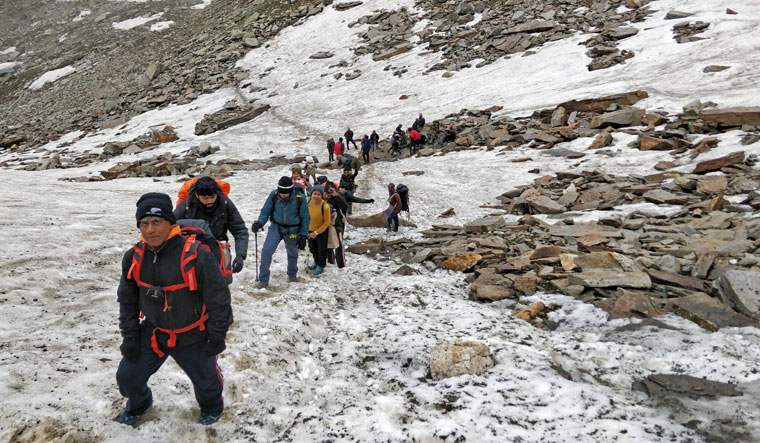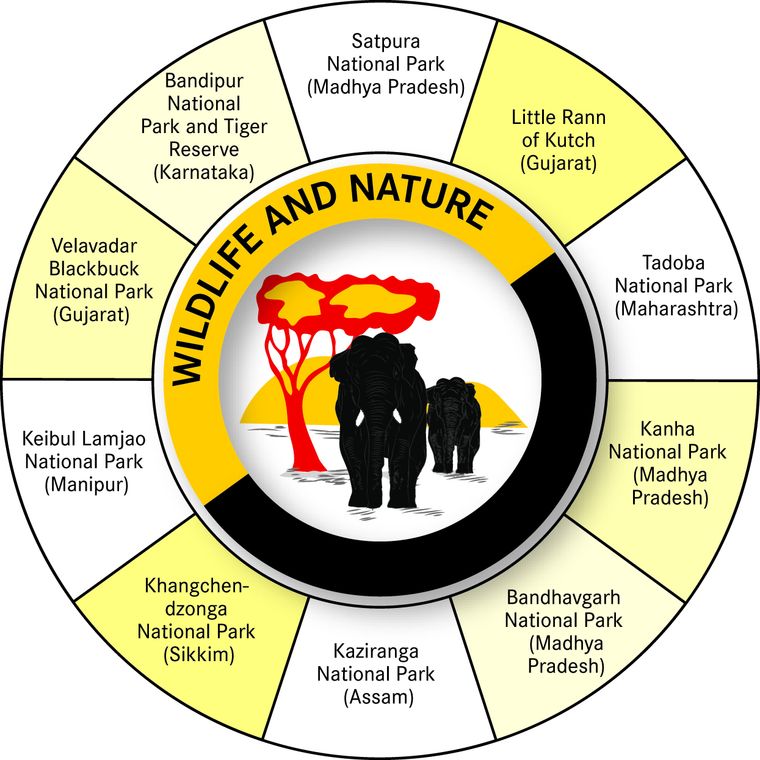When was the last time you went without checking your phone for six days together? When did you last drink mineral water, not out of a plastic bottle, but straight from glacier-fed Himalayan brooks? When did you last—or ever—play frisbee standing on opposite banks of a river. If you are still thinking, setting out on the Rupin Pass trek might give you the answers!
This high-altitude Himalayan trek, graded moderate to difficult, takes you from Dhaula in Uttarakhand to Sangla in Himachal Pradesh, across the Rupin Pass situated at 15,350ft. I set out on this incredible journey last summer with 17 other trekkers. The trip starts in Dehradun, and after an eight-hour drive via Mussourie, we reach Dhaula, where our camp is already set by the Rupin river.
“Chalo guys, out of your tents, everyone. I want all backpacks and sleeping bags out. Kanav, react,” bellows our trek leader Taarak the next morning. “Everyone, have your breakfast, and let’s go, let’s go, let’s go.”
It may sound a bit pushy, but in all fairness to him, it was necessary. We were snug in our tents, tired after a long drive.The collective lethargy of 18 of us is a formidable force that needs to be countered.
By 7am, we begin our trek in all earnestness. Destination: Sewa village. The initial climb is steep, but the trail soon softens to a comfortable gradient through coniferous forests that trace the course of the Rupin, a constant companion in the valley below. By afternoon, we reach Sewa, where we have lunch by an intricately carved, wooden temple that has many coins wedged into its walls. It looks as though its architects started out by building a clock tower, but then figured that a Buddhist monastery was more what they wanted, so they topped it off with a pagoda-like roof.
We reach our camp early enough in the evening to enjoy a cool dip in the many rocky pools that form as the turquoise Rupin thunders past, dashing against massive boulders along its path. As the sun dips, and the shadows lengthen, the dimness of the woods creeps over our camp. Slowly but surely, it gets darker and quieter, and the cold, clear night, with its noiseless tread, is upon us. Our destination on day three of the trek is the tiny hamlet of Jiskun in Himachal Pradesh. It is the only night we will be staying indoors in a home-stay. The journey takes us through apple and apricot orchards and past many waterfalls.
Once at Jiskun, we rid ourselves of the trekking gear, and wander about the village, ending up at the local primary school. Everyone has gone home for the day, except three students who invite us to play kabaddi in their playground. It is a closely contested match, which, unfortunately, is called off due to a steady drizzle. We rush back to our home-stay, where our hosts, a pahadi couple, have prepared steaming hot momos and the most delicious homemade sauce. It is the ultimate mountain luxury, and our hosts do a great job of keeping up with the ravenous strike rate of 18 hungry trekkers.
Well-rested and well-fed, we head towards Jhaka on the fourth day. It is a fascinating walk early on, as we wind our way single file on narrow mountain ledges, with rough overhangs on one side and vertical drops into the valley on the other. The dense, swaying canopy of pine and deodar trees spreads out like a green ocean below.
Beyond Jhaka, the trail cuts through a dense fir and pine forest and the century-old trees tower so high that their tops are lost in the thick canopy. The sun barely manages to sneak in to the forest floor. This leg of the journey, on foot trails made by shepherds with their flocks, is as relaxing as it is pretty.
On the fifth day, the camp at Dhanderas Thatch is arguably the prettiest of the entire trip. Situated in the alpine meadows of the Rupin Valley, the Lower and Upper Waterfalls, as they are commonly known, make a formidable backdrop, while many smaller ones run down on either side of the camp. Once we are settled and the tents pitched, the brave among us take up the Ice River Challenge. A dunk in and out of the chilled snow-melt is a brain-numbing experience, and definitely not for the faint-hearted. Day six is the toughest and longest day of the trek. We reach the Lower Waterfall quickly, crossing over thick ice bridges. The journey to the Upper Waterfall, however, is a steep and arduous climb. The roar of the cascading water drowns us in surround sound, quite literally. Slanting sun rays, just beginning to slice the ragged peaks, strike the waterfall and split into a magnificent rainbow. The sheer, mad beauty of it all makes the ascent a most rewarding experience. We rest here awhile in silence, letting the magic sink in. It is difficult to resume the trek and turn our back on this grand panorama. By the time we reach our camp at Rata Pheri, we are exhausted.
“Guys, tomorrow is the big day,” Taarak briefs us before we hit the sack.
It is summit day and, incredibly enough, the trek starts on schedule. It is important to start well before sunrise because the snow that has turned hard overnight will turn soft and slippery during the day.
The final ascent to the pass is a stiff 70-degree climb that is done in single file with utmost caution. Each trekker uses the foothold that the one in front has carved out of the hard snow. And, step by step, foothold by foothold, we conquer Rupin Pass. The many hours spent at the gym strengthening those quads and hamstrings finally pay off. We are at 15,350 ft above sea level, and our collective egos, proud of the achievement, are a dozen metres higher.
It is time to put our feet up and lord over the Dhauladhar range of the Himalayas. Up here, you cannot but be awed by the majestic mountains, the pristine rivers, the thundering waterfalls and the star-studded night skies. And the pure mountain air—that rarest of commodities. As I breathe in deliberate lungfuls, I am reminded of Henry David Thoreau’s experiment, which he describes so beautifully in Walden:
“I went to the woods because I wished to live deliberately, to front only the essential facts of life, and see if I could not learn what it had to teach, and not, when I came to die, discover that I had not lived.”
This summer, trek to feel alive. Trek to disconnect with your phone and reconnect to something else. Trek just to feel humbled and insignificant in the mighty mountains. God knows we need that the most.




